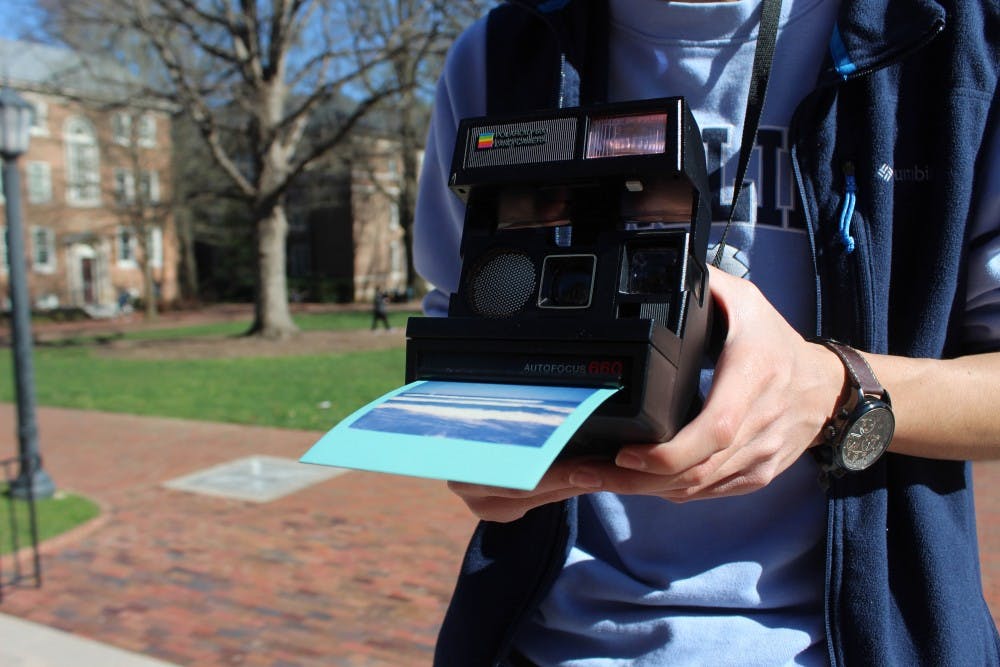“I think it’s because we’re sick of the screens — scanning and sliding and scrolling through everything from fake news and images to our lives and personal information,” Slavick said. “We want something tangible, and we want to slow down and make real images. I think it’s a much bigger phenomenon than just a fad of the Polaroid.”
Slavick owned a Polaroid in high school and now owns multiple in her collection of cameras as an adult. Slavick helped build UNC’s current darkroom, which she has been working in for 26 years. She said film is her real passion, but Polaroids are a fun break that can be used really creatively depending on the artist.
“The whole beautiful thing about the Polaroid is that it’s a unique, one-of-a-kind object. Right?” Slavick said. “It’s immediate and it spits out a camera so it’s like fast magic. It’s wonderful.”
First year Melissa Smith’s dorm wall is covered in Polaroids from memorable events in her life from Christmas gatherings to spring break trips in Miami.
“It’s different than a picture on your phone because that you can just scroll by or delete, but this is like a physical object,” Smith said.
First-year student Tina Vo has nine years of photography experience but only got into Polaroids in the last two.
Vo said that she enjoys the raw image captured using a Polaroid versus a digital image through a DSLR or iPhone that can quickly be modified.
“It’s a moment that you can’t edit or try to improve or alter,” Vo said. “It’s in it’s most natural state. I think being able to print out the picture instantly and slide it into a wallet just is so much more personal.”
In addition to the wallet, Vo said she often hangs her smaller images on the dorm wall by her desk in order to relive memories.
“If I’m stressed, it kind of relaxes me and brings me back to a simpler time,” Vo said. “Usually I bring Polaroids on trips or vacations, so it’s a nice way to de-stress.”
Vo is not the only one who has recently picked up a Polaroid. The Fujifilm Instax is Amazon’s top-selling camera, including digital, across the board according to The Ringer.
Prachith said he often uses a Polaroid that prints larger images than the popular Instax film size, 3.5 by 2.3 inches.
To get the day's news and headlines in your inbox each morning, sign up for our email newsletters.
For Prachith, shooting on any kind of film forces him to slow down and think about the photo they want to capture.
“I think with Polaroids in a pack you have like eight or 10 — that’s all you get,” Prachith said. “And when you’re shooting on film, you only have a roll that’s 24 or 36 images, so you really have to be deliberate with whatever image you decide to capture.”
Slavick identified the time it takes to use film in comparison to a click on a phone camera as a reason why creatives are renewing their love for the Polaroid.
“I think it slows you down, and it makes you really think more and harder and deeper about what you’re doing,” Slavick said.
The limited number of images also comes at an expense. The “Best Seller” pack of 60 Instax mini film photos costs about $35 on Amazon. For photographers like Smith, this is a reason why she's careful about what she chooses to shoot on her Polaroid.
“I’ll take pictures of anything with my phone because that’s just storage, but with a Polaroid, I pretty much save that for if I know I’m doing something really special,” Smith said.
Vo said a refreshing break from the familiar, curated picture can be found in the tiny instant image.
“In our society, we’re so used to Photoshopping and editing all pictures that you see online and sometimes it’s hard to get away from that unnatural image and standard,” Vo said. “With the Polaroids, it’s just something you can’t change. ... It’s just a cozy feel. It's a memory that you can’t recreate.”
arts@dailytarheel.com




